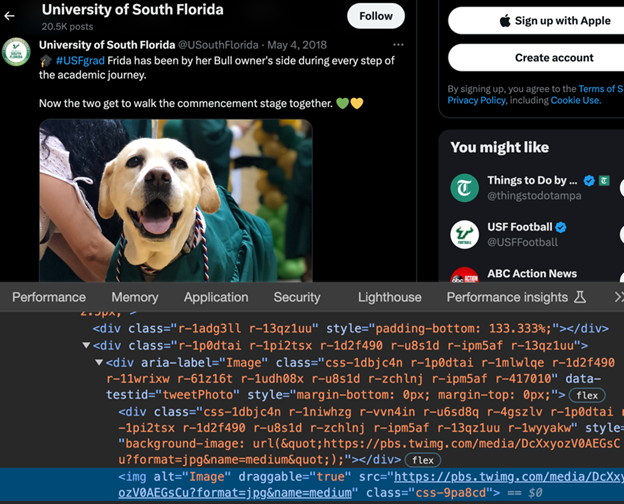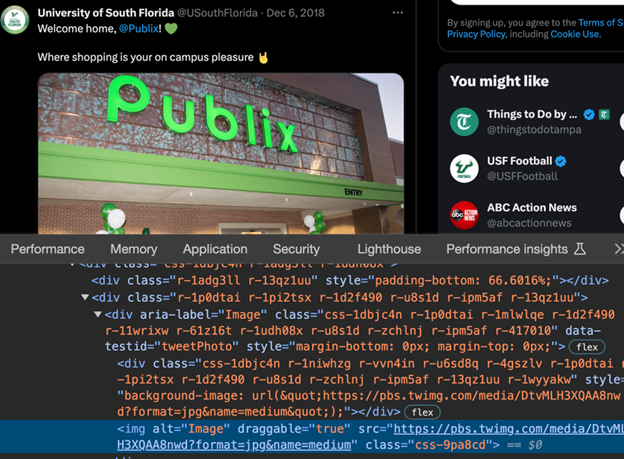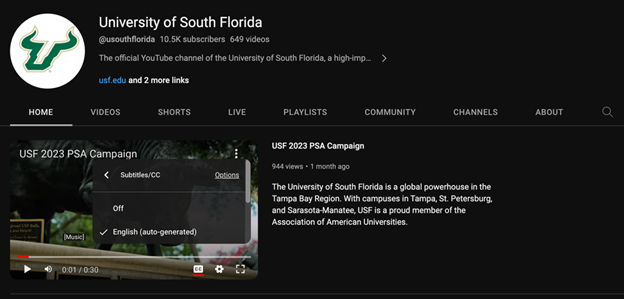Summary

The U.S. Department of Education’s Office of Civil Rights (OCR) investigated the New College of Florida for not making its website and social media accessible to everyone. A public liberal arts institution, New College of Florida, said it settled with the OCR by saying it will correct the inaccessibility issues in the next eight months. However, they did not indicate how they plan to achieve this.
What’s interesting is that New College of Florida isn’t the first Florida educational institution to come to an agreement regarding its website and social media issues. OCR has made similar agreements with other Florida public institutions with similar inaccessibility issues. While this article focuses on a specific institution, we believe this is a problem across many institutions in the U.S. And we explore an example with another Florida educational institution
Ken Nakata from Converge Accessibility and Equal Entry CEO and founder Thomas Logan discuss OCR and how they work using educational institutions as an example.
What Is an OCR Complaint? How Is It Different from a Lawsuit?
Thomas Logan: Ken, I was just reading about New College of Florida settling a disability complaint with the Education Department and it got me thinking, what is an OCR complaint and how is that different from a lawsuit?
Ken Nakata: An OCR complaint is a complaint that’s filed with the Office of Civil Rights at the Department of Education.
It’s an informal process where the Department of Education goes and investigates the complaint, and they issue usually a letter of findings at the end of the process to resolve the case. And normally these cases aren’t filed in court, and they’re just settled privately. But they do get a lot of attention because educational institutions want to know what their obligations are.
Thomas Logan: That is really interesting, after you told me about that, I went and looked on their website, and I see they’re making quite a lot of these letters to educational institutions, so it looks like a lot of people have received letters that are OCR complaints in the United States. Is that true?
Ken Nakata: Yes, it is.
I have a friend who works over at the Department of Education in OCR, and their processes are a little bit different from other federal agencies. So for instance, if you file a complaint with the Department of Justice, that doesn’t necessarily mean that the Department of Justice is going to open the case and investigate it.
By contrast, if you file a complaint with OCR, they first figure out whether it is something that’s under their coverage, whether it’s something, an area of law that they can do anything about. And if it is, then OCR is required by its own processes to investigate that complaint. So they have quite a large backlog of cases, and a huge workload. And so that’s why their staff is quite a bit larger than the Department of Justice’s for handling disability claims.
A Look at an Example OCR Letter for the University of South Florida
Thomas Logan: All right. Well, I’d like to take an example of a real OCR letter and agreement. So up here, I’ve decided to look for the University of South Florida because it’s from February 7th of this year, 2023.
So let’s take a look at the letter that was sent. Ken, what are you seeing here when we open up this letter?
Ken Nakata: It looks like a typical OCR response letter. So in this case, the OCR is responding to the university telling them that they’re resolving this case that they were previously advised of. It gives the basic allegations in the complaint and what the university is going to do to settle it.
Typically, these letters aren’t very long.
Thomas Logan: I like the brevity here. It mentions OCR conducted an assessment of the university’s online programs, services, and activities and noted possible compliance concerns including, but not limited to. Then it gives three real examples of items that they identified.
One about logical reading order, one about the content being obstructed by navigation menus when using the keyboard, and one about the content being obstructed when the page was magnified. So three really clear accessibility issues in my mind. It’s nice to see a short, simple list of items that are big issues that exist.
Ken Nakata:, I think that that’s true. And it’s a fairly succinct list and it doesn’t include things like the ones you often see things like missing alt attributes and things like that, but does present some real issues that blind users actually are likely to encounter or keyboard-only users are likely to encounter.
Thomas Logan: Exactly, and I think this is part of our further discussion here, but goes into the whole point that to provide a full assessment or to do a full test in a comprehensive set of results, this document would be enormous, given the size of the University of South Florida’s website and social media and documents. So keeping it short is great for a letter, but then as we get into the details, I’m sure when this letter was written and sent off, there were so many different other issues.
So even though they’re saying here’s three, they’re saying, but not limited to, and there’s quite a lot of other issues not mentioned here.
So why don’t we now look at what they agreed to in the University of South Florida resolution agreement, and maybe you could set us up with how does that usually works in the process between a letter and an agreement being reached?
What Did the University of South Florida Agree To?
Ken Nakata: Ordinarily the letter accompanies the agreement or it’s done almost at the same time. And the reason is that the letter states that we’ve come to this resolution. The actual agreement is something that has been tossed around between the attorneys for OCR and the attorneys for the university for quite a while.
It usually includes a lot of broad remedial kinds of provisions to make sure that the university is in compliance. But I almost have had some issues with these because of the terms that the universities or the defendants usually agree to, I think that they sometimes don’t know exactly what they’re getting into.
Thomas Logan: Yes. So it sounds like, from this agreement letter, the date they agreed to this was February 2, 2023. So let’s take a look at what they agreed to, or just a few things that they agreed to.
So the first thing I see that they agreed to is to adopt an accessibility standard. So within 30 days of that signature date, the university will adopt a widely accepted accessibility standard, such as Web Content Accessibility Guidelines (WCAG), version 2.1 level AA. Interesting they do give them the option to do another standard that requires an equivalent level of accessibility for people with disabilities. But I bet most people stick with WCAG 2.1 level AA. What do you think?
Ken Nakata: Absolutely. They did everything except tell them to do WCAG 2.1 AA.
So another provision that’s in here is that within 120 days, so what’s that, four months after the agreement the university has to complete an audit to identify barriers on its websites. And that audit includes two parts, really. It includes first, creating an inventory of pages for manual testing, and then conducting the manual testing.
So, under creating the inventory, they require the university to create this inventory of some pages that are on the university’s domain, and some pages that aren’t on the university’s domain. So the pages that are on the university’s domain, they only say, OK, just do the home page, first level landing pages, and all web page templates are not otherwise captured.
And to me, that seems a really reasonable ask. Where it gets a little bit hairy, though, is in the second element, which is all URLs that are outside the university’s domain, including those on vendor-hosted or third-party hosted sites, including social media sites and video hosting services, and that’s going to be quite a few.
That’s all those videos that they use in all their course content that are used by the university to communicate or facilitate its program services or activities to members of the public. That is potentially huge because that includes basically any cloud-based service or any vendor-hosted service where they’re using that other service outside their domain.
To do something that helps them in their educational mission, basically. And that’s a subjective area of what that means. And then after you’ve figured out what that big inventory is, then they require manual testing on all of that content. That I thought is a little bit tricky.
Thomas Logan: And I’ll agree with that.
I was really excited when I saw No. 1, because I thought, wow, this is a little more realistic to mention the homepage first-level landing pages and then webpage templates, not otherwise captured. That’s going to be a much smaller set of pages that in my mind is potentially testable and knowable, but when we got to number two and you get to all URLs, you start being like, that can be thousands, 10 thousand, hundreds of thousands, depending on the size of the institution. That becomes a lot harder to believe you can actually manually test that.
Ken Nakata: I’d really like to see what that inventory looks like.
Thomas, I noticed that the next provision is about how they have to fix all these barriers within six months. And there are a lot of other provisions in this OCR agreement. But I thought, well, gee, that’s really the real meat and potatoes.
There’s paragraph number four where they have to engage in remediation.
How are They Doing Six Months Later?
Thomas Logan: I agree. So why don’t we pull up the University of South Florida’s web page and see if they’ve remediated all the accessibility issues on it?
Ken Nakata: Yes.
Thomas Logan: It’s been six months. I mean, it’s October 10th. It’s been six months.
Ken Nakata: Exactly. So it’s perfect timing.
And we know that their homepage is in the scope of this because that was the easy part of the scope.
Thomas Logan: Right. So, unfortunately, this was just taking a few minutes to assess this. The first thing I tried was tabbing through the webpage. Remember there was the first bullet point of the three bullet points that were in the letter was about the logical reading order of the page.
And what we have on this webpage is a couple of different headers and headings. But what we find as we start tabbing through the webpage, we move to the logo, which is the University of South Florida, which might be an okay place to start. But then once we start working from a logical fashion, we should be working left to right, top to bottom.
When I press tab, I actually move up on the screen up higher to a search button that’s up in the top right of the screen. I press tab, I move down to something that’s labeled “GIVE NOW.” I press tab and now I’m on a navigation menu. That’s actually in logical order. But as I continue tapping, my tab now jumps back up to the top of the page and I’m on a link called “Students.”

And if you’re listening to this as a podcast, check out our webpage where we’ll have image examples of what we’re talking about to illustrate it. So that’s just number one. Anytime you have the focus order hopping around, it’s not in a logical order. And we can see that just from the very first few, maybe the first 15 tap strokes I take on the webpage.
I see that’s still a problem here, October 10th. So now let’s do two examples from their social media. Those were included under number two. Anything that’s being used on a third-party site to communicate about programs and services. So I’m going to go to X and I’m going to look at their posts.
And oh, look on this page, we have a tweet: “#USFgrad Frida has been by her Bull owner’s side during every step of the academic journey. Now the two get to walk the commencement stage together.” And I’m seeing a really cute dog wearing a similar graduation outfit as I assume their owner is. But when I go to check if there’s alt text for that cute dog, all it says is alt=”Image.”

Wow, that’s not enough? Well, let’s try one more tweet though, because that was just the first one. The next one is, “Welcome home @Publix! Where shopping is your on campus pleasure.” And again, we have an image here of a bunch of people outside of Publix, but still using alt=”Image.” So, the very first two tweets we find on X don’t have text alternatives.

Now, let’s try one more. Let’s go to YouTube, a popular place to talk about your university. I just looked at the very first video featured on the YouTube page for USF, and I saw that when I select the captions or subtitles, they’re just relying on auto-generated captions for the highlighted video on their homepage.

So again, just in a real quick test, not digging into this video, but just by the fact that they’re using auto-generated captions. We know they haven’t put work or review into ensuring that this video has been made accessible. So Ken, you know, I’m, I’m a little shocked. Like why would a lawyer agree to have all these things checked and verified if we can find so many issues over six months later?
Ken Nakata: Yeah, I think there’s a couple of things going on here. First, I don’t think that the attorneys who sign these agreements ever have any true appreciation of the difficulty of manual testing and what they’re really committing themselves to. And a cynical person could say, well, yeah, but it doesn’t really matter because the attorneys are probably never going to follow up on finding these violations.
And there’s some truth to that cynical perspective. I think that on the one hand, there it’s trying to cure the really big problems and often those big problems do get taken care of or sometimes in this case, as you pointed out, Thomas, they didn’t get taken care of, but the attorneys don’t really ever follow up to really make sure that every webpage really does comply because, well, they just don’t because it’s too difficult for them to do it.
And it’s awful. On the one hand, I really believe that when you sign up for something and you agree to do something, if you’re a defendant. You better make darn well sure that you’re able to do that thing, whatever it is. In web accessibility, we just don’t have that. People sign agreements like this all the time.
I’m sure that you found out with a lot of your clients who have been in lawsuits that when they settle the case, a plaintiff usually asks for some sort of compliance with WCAG. And they usually agree, and I can tell you, I mean, not necessarily with our clients but I’ve met with other clients that I’ve seen that we all know have gotten sued.
You come back a year later and their site is not compliant in any way, shape, or form.
Thomas Logan: I wanted to add to that, just to make sure. I don’t want to say this is specific to the University of South Florida at all. In fact, Ken and I just picked one of these cases at random. And honestly, I think I could have picked almost any other case and seen similar results.
You know, maybe not. But again, this is just taking five minutes, right? And looking at the first video, the first tweet, and the homepage. That’s not even the agreement, right? Like, they were agreeing to way more pages than we did, and I think that’s just a huge problem we have to start talking about more in web accessibility.
Like, I’d love to get first, let’s get really real about your latest tweet, your latest video, and your home page. I’m like, until I see that, why am I even going off into these other areas? Because I want to see that working, and I feel like the process that you implement to get that working is the same process that you can use on all the other pages. But if we can so easily see that you’re not following a process for your most important pages, it really does call into question, like, what are these OCR complaint letters and agreements actually achieving?
Ken Nakata: Yeah, I agree. I think that when you create laws that people completely violate and they don’t create processes around these things to really meaningfully comply with something, I think it ultimately undermines the whole idea of complying in the first place.
And so when we’ve got cases like this, or any other case where people just say, “Okay, fine, I’ll comply with WCAG, but really I won’t.” It gives accessibility a bad name. It just makes accessibility seem like a plaintiff’s tax as opposed to actually making things accessible for people with disabilities.
Thomas Logan: So, hey, listeners and readers, what can we do? What should we do?
I think this is a really important discussion and we hope to keep having discussions like this in the future. Thanks for checking out our content.
Accessibility Compliance Help
Our years of experience working with lawyers and being expert witnesses in lawsuits have given us a unique perspective when it comes to explaining and justifying our clients’ accessibility compliance.
If you are experiencing any legal issues related to the accessibility of your technology, please contact us to discuss how we can help.